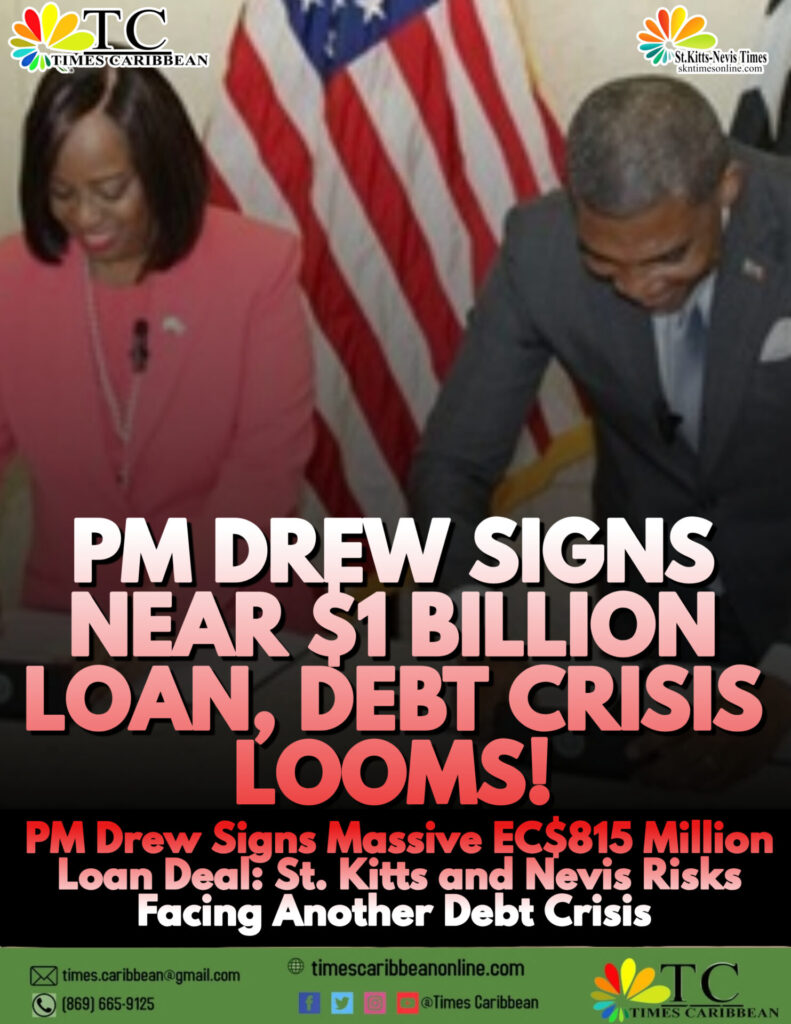PM Drew Signs Massive EC$815 Million Loan Deal: St. Kitts and Nevis Risks Facing Another Debt Crisis

In a controversial move, Prime Minister Dr. Terrance Drew has signed a Memorandum of Understanding (MOU) with the Export-Import Bank of the United States (EXIM), securing up to EC$815 million in financing. This near-billion-dollar loan, with scant details on its terms or intended projects, has ignited widespread concern about the financial future of St. Kitts and Nevis.
The loan comes just two years after the Drew administration took office, inheriting a nation celebrated for its fiscal prudence under the leadership of former Prime Minister Dr. Hon. Timothy Harris. Under Dr. Harris’ stewardship, St. Kitts and Nevis achieved an unprecedented milestone in 2018, becoming the first independent state in the Eastern Caribbean Currency Union (ECCU) to lower its debt-to-GDP ratio below the 60% benchmark. By 2019, the ratio had fallen to 56.4%, and the country operated without taking on new loans for seven years.
In contrast, critics now warn that this new debt risks undoing years of hard-won fiscal progress. The near EC$1 billion agreement could increase the country’s debt-to-GDP ratio significantly, raising fears of a potential return to International Monetary Fund (IMF) oversight. Such a scenario may lead to austerity measures, including higher VAT rates, increased government fees, and further burdens on citizens.
Recent policy changes have already raised red flags. The government announced hikes in commercial electricity rates, and just today, SCASPA (St. Christopher Air and Sea Ports Authority) revealed increased fees for business operations and equipment. With these developments, the new loan only adds to growing public anxiety about the nation’s economic direction.
Fiscal Prudence vs. Financial Uncertainty
The Drew administration’s lack of transparency regarding the loan terms and the projects it will fund has further fueled skepticism. The EXIM Bank indicated that the funds would support renewable energy, cybersecurity, and critical infrastructure, but no concrete plans have been outlined. This uncertainty contrasts starkly with the Harris administration’s debt management strategy, which emphasized primary surpluses, open debt restructuring, and fiscal responsibility.
Risk of IMF Oversight
A return to IMF oversight would mark a dramatic shift for St. Kitts and Nevis, which once stood as a model of economic stability in the Caribbean. The Harris administration had successfully exited IMF programs and maintained fiscal independence, relying on strategic policies and surpluses rather than debt.
Public Reaction
The announcement has sparked outrage among citizens, with many questioning the government’s priorities and long-term planning. “This is a betrayal of the fiscal stability we worked so hard to achieve,” one economist stated. “A debt of this magnitude will weigh heavily on future generations.”
What’s Next?
As the Drew administration faces mounting scrutiny, citizens and financial analysts alike are calling for greater transparency about the loan’s terms, repayment schedule, and impact on the economy. Without clear answers, the specter of ballooning debt and economic strain looms large over St. Kitts and Nevis, threatening the fiscal gains of recent years.

Leave a comment
You must be logged in to post a comment.